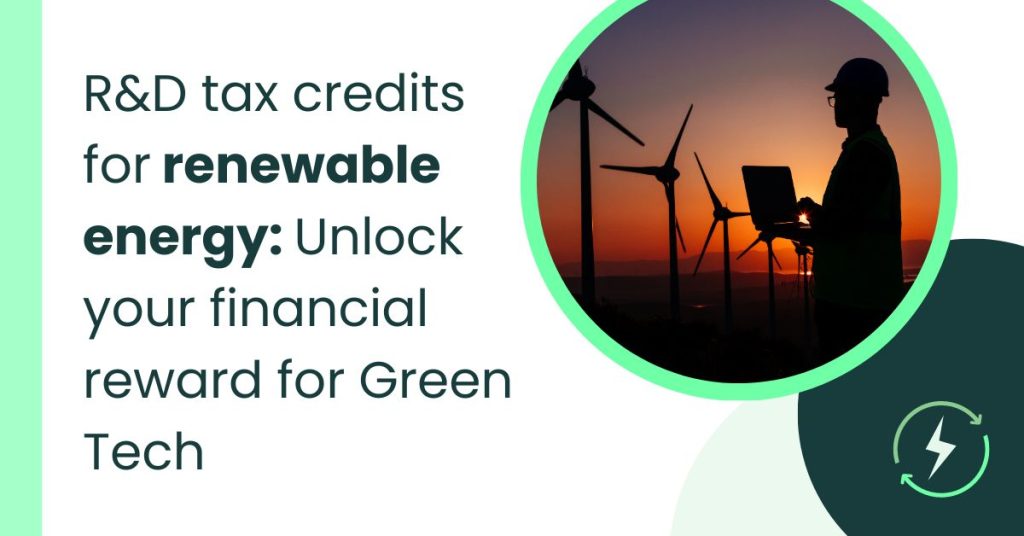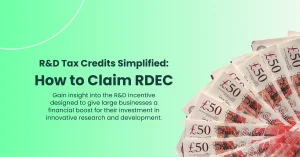Understanding the role of R&D in the renewable energy industry

The renewable energy sector, also known as green tech, looks at ways to make our planet greener, by improving and prioritising the production, distribution, and utilisation of sustainable energy sources. These include solar, wind, hydropower, and geothermal energy. Choosing these over non-renewable resources mitigates the environmental impact that the energy sector has caused on our planet, and this is a core component of what research and development is all about. The financial incentive of R&D tax credits aims to offset costs associated with qualifying R&D efforts, promoting the development of cleaner and more efficient energy technologies. This article will explain the key information you need to know about claiming for R&D in the renewable energy industry.
What is the importance of R&D in the renewable energy industry?
The existence of R&D projects in renewable energy showcases changing priorities for pro-green values and a sense of urgency about the climate crisis. Transitioning to renewable energy sources not only addresses the critical issue of climate change by reducing greenhouse gas emissions but also ensures a more secure and resilient energy infrastructure. Businesses investing in renewable energy not only contribute to global efforts to combat climate change but also stand to benefit economically. The utilisation of renewable energy is on the rise; it was recorded in 2022 that 30% of our electricity comes from renewable energy.
Renewable energy is truly the way forward, let’s discuss a few examples of how R&D is elevating the industry to help the economy.
Reduces greenhouse gas emissions
Transitioning to renewable energy sources significantly reduces greenhouse gas emissions, as technologies like wind, solar, and hydropower generate electricity without emitting carbon dioxide and other pollutants associated with conventional fossil fuels. This reduction in emissions plays a crucial role in mitigating climate change, contributing to global efforts to limit temperature rise and its associated environmental impacts.
Lowers long-term energy costs
Embracing renewable energy not only aligns with environmental goals but also offers a compelling economic advantage by lowering long-term energy costs. The cost of energy from fossil fuels can fluctuate with political tensions and global events. Because renewable energy doesn’t run out the way fossil fuels potentially could, it is much more cost-competitive. Businesses investing in sustainable energy sources can benefit from reduced operational expenses over time, providing a strategic and financially prudent approach to energy management.
Enhances public health
Renewable energy sources contribute to improved public health by mitigating the negative impacts associated with air and water pollution from traditional fossil fuel-based power generation. Pollution is contributed by the use of fossil fuels in transport, industrial activities, and burning in urban centres, for example. The shift to clean energy helps reduce respiratory and cardiovascular diseases, creating healthier communities and alleviating the burden on healthcare systems.
Preserves natural resources for future generations
R&D in renewable energy reduces the extraction and depletion of finite fossil fuel reserves. Unlike non-renewable sources, renewable energy, such as solar and wind power, harnesses the Earth’s natural processes without depleting essential resources, ensuring a sustainable energy future for generations to come.
Creates new job opportunities
Renewable energy drives demand for skilled workers in various sectors, including manufacturing, installation, and maintenance of solar panels, wind turbines, and other clean energy technologies. As the renewable energy industry expands, it stimulates economic growth and provides employment opportunities, supporting a workforce dedicated to advancing sustainable practices and combating climate change.
Understanding what counts as R&D in the renewable energy industry
Unfortunately, awareness about what counts as R&D within renewable energy is low. To put it simply, if you’ve spent money on energy production, whether that’s for making an improvement or designing brand new prototypes, developing, or experimenting with materials or physical production processes, then you could have an R&D tax claim on your hands. The renewables sector is huge and so is the eligibility scope for R&D. HMRC wants to reward businesses who attempted to overcome a technical or scientific uncertainty without knowing if the project would be a success or not.
In the context of the renewable energy sector, this could look like.
Solar cell technology advancements
Researchers may engage in R&D to enhance the efficiency and cost-effectiveness of solar cells. This could involve developing new materials, improving manufacturing processes, or exploring novel designs to capture and convert solar energy more efficiently.
Wind turbine innovation
Ongoing R&D efforts in wind energy focus on improving the design and efficiency of wind turbines. This includes exploring advanced blade materials, optimising aerodynamics, and developing innovative technologies to harness wind power in different environments.
Energy storage solutions
Research is conducted to improve energy storage technologies, such as advanced batteries and energy storage systems. This R&D aims to enhance the reliability and performance of renewable energy sources by addressing intermittency issues and enabling better integration into the power grid.
Bioenergy research
R&D in bioenergy involves developing new biofuel technologies, improving the efficiency of bioenergy production processes, and exploring sustainable biomass sources. This contributes to the development of cleaner and more sustainable alternatives to traditional fossil fuels.
Hydropower efficiency and environmental impact
Ongoing research in hydropower focuses on increasing the efficiency of hydropower systems while minimising their environmental impact. This includes innovations in turbine design, fish-friendly technologies, and improvements in dam operations.
Geothermal exploration and enhanced technologies
R&D efforts in geothermal energy involve exploring new geothermal resources, developing enhanced geothermal systems (EGS), and improving drilling technologies. These initiatives aim to expand the reach and viability of geothermal energy as a renewable resource.
These examples highlight the diverse areas of research within the renewable energy sector, each contributing to the advancement and sustainability of clean energy technologies. It’s important to keep in mind that for your project to meet the eligibility criteria, you don’t need to be inventing something new; you can be improving something already existing.
What does the R&D tax credit incentive achieve for the renewable energy sector?
R&D tax credits allow corporations to offset a portion of their research and development expenditures against their corporate income taxes or, in some cases, receive a cash payment if the credits exceed their tax liability. Here are some ways R&D tax relief make a huge impact on the renewable sector.
Drives growth towards the achievement of the Net-Zero 2050 goal
The R&D tax credit incentive drives growth toward the achievement of the net zero 2050 goal by encouraging increased investment in research and development for innovative, sustainable technologies within the renewable energy sector. This financial support fosters the development of breakthrough solutions, accelerates the deployment of cleaner energy alternatives, and enhances the competitiveness of companies contributing to the transition to a low-carbon economy, ultimately advancing progress toward the net zero emissions target by 2050.
Increases market competitiveness
As the global demand for clean and sustainable energy solutions grows, countries aim to position themselves as leaders in the renewable energy sector. R&D tax credits enable companies to stay competitive by investing in cutting-edge technologies, staying ahead of the curve, and meeting the demands of an increasingly environmentally conscious market.
Stimulates economic growth
The R&D tax credits help stimulate economic growth within the renewable energy sector. As companies invest in research and development, they create jobs, hire skilled professionals, and contribute to the overall expansion of the renewable energy workforce. This growth is beneficial for both the industry and the broader economy.
Final thoughts
In conclusion, R&D projects prioritise pro-green values, reflecting a changing perspective on the climate crisis. The importance of R&D in the renewable energy industry lies in reducing greenhouse gas emissions, lowering long-term energy costs, improving public health by minimising pollution, and preserving finite natural resources for a sustainable energy future. By encouraging investment in research and development, R&D tax relief not only promotes the discovery of cutting-edge technologies but also facilitates cost reduction, accelerating the deployment of renewable energy solutions.
How can we maximise your R&D claim?
As trusted R&D tax credit specialists, our team has sector-specific knowledge of renewable energy as well as a successful track record of R&D claims. No matter the complexities within your project, our team can piece together a strong claim that highlights your innovation to HMRC, meeting their exact standards to prevent the risk of a time-consuming enquiry. We advocate your great idea and retrieve the financial reward you’re eligible for in a few steps. Get in touch to discuss how we can help you!







